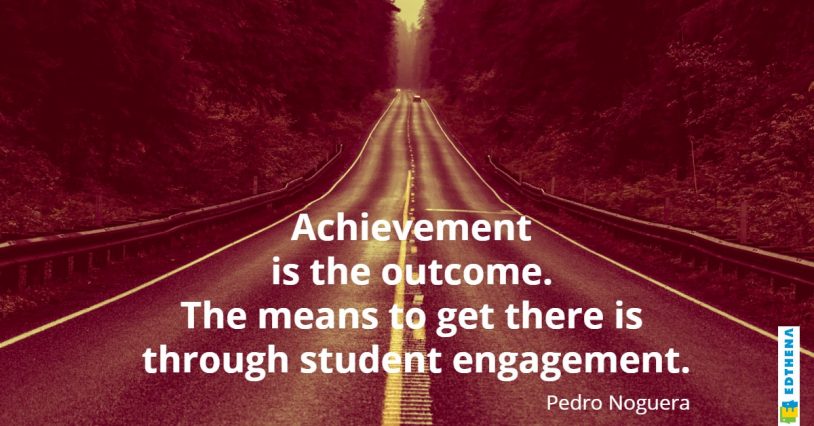Pedro Noguera Examines How Student Engagement Impacts Student Achievement
- Student achievement should not be guided only by listening and sitting but should be driven by being an active participant
- The curiosity of students is the best way to learn willingly
- Teachers can honestly speak about how they are learning something new to help students understand that even teachers make mistakes
Pedro Noguera is the Dean of University of Southern California Rossier School of Education. His journey started in the classroom, moved to the school board, and now to the collegiate level. This understanding gives Pedro a unique perspective that few have in the industry.
From his expertise, Pedro holds to the fact that student engagement impacts student achievement. Pedro was interviewed for the teacher professional development blog PLtogether to share his thoughts on the matter. You can check out part 1 of this 4-part interview above and the highlights you can observe below.
Recognizing engagement is the pathway to student achievement
Some teachers have gotten the wrong idea that engagement from students should only look a few ways. But, Pedro is vehement that engagement should be multi-dimensional.
“Kids don’t learn by sitting and listening; they learn by doing,” Pedro said.
The proof is truly in the pudding. Pedro knows that making connections to what is going on in the classroom makes all the difference. When students understand what they are doing, emotions start to kick in. Then, learning becomes applicable.
From there, students need to be able to communicate what they are learning. This is why checking for understanding has such a massive influence on overall student achievement. Students can nod their heads in agreement, but how does the teacher know that the comprehension is not muddled? How do we know that one particular student is not just nodding his or her head in unison with the rest of the class? How can the teacher confirm that the student understands the entire problem and not just parts of it? There are so many things to consider, which is why it is so important for the teacher to check for understanding by asking individuals to rephrase the learning back.
This application process is vital, whether the school environment is in-person or online. Sadly, Pedro thinks teachers have more of this listening and sitting happening than student engagement in their current classroom settings.
Bringing engagement into virtual or distance teaching
Pedro shared how one of the best ways to encourage student engagement was for the teacher to tell the class that learning can involve mistakes. This may seem simple, but Pedro said this verbal cue can be significant.
The invitation to make mistakes can completely shift the perspective for students. By knowing that learning something new likely involve mistakes, students may be willing to take more risks, answer more questions, and think more outside of their comfort zone.
Pedro shared, “Let kids know that when you are learning something new. It is okay to make mistakes.”
When teachers create this kind of atmosphere, students will be willing to ask questions. They will know there is no such thing as a dumb question. This way, teachers can focus on student questions and teach with a priority on evidence.
A constant check for understanding will increase student engagement. In return, student achievement will be easier to gauge, too.
The pressure to achieve, and the engagement strategies to get there
 In the interview, Pedro shared, “Achievement is the outcome. The means to get there is through student engagement.”
In the interview, Pedro shared, “Achievement is the outcome. The means to get there is through student engagement.”
When students are willing to work and apply themselves, teachers should use this to their advantage. Students are not always excited to learn. But when they become engaged, even if they originally thought the concept was boring or tedious, a teacher has successfully tricked them into becoming active learners.
“If you can tap into the curiosity of kids, they are more likely to become willing learners,” continued Pedro.
Force-feeding students is never a good idea, from Pedro’s perspective. When this happens, students learn passively. Teachers may find themselves surprised as to what their students find interesting about a particular subject. Perhaps one student thinks that math is “boring” but is fascinated by the concept of money. Or maybe a student thinks they have no interest in geography, but loves drawing and thus could be up for drawing a detailed map. By harnessing their students’ curiosity on different nuances of a particular subject, teachers can bring a lesson to life.
Giving student opportunities for independent learning
Pedro ended the time with an example of a former student of his. The student, now grown up as a teacher, was tasked with teaching English literature, and teaching Shakespeare was the focus. His students were not enjoying themselves in the slightest.
The teacher wisely called an audible and started bringing the story to light. Questions like “Have you ever had issues with your mom before?” and “Have you been angry with your mother before?” were asked. The answers were “yes” for many of his students.
At that point, students got hooked because, in Hamlet, an issue involved his mother possibly killing his dad. When the story moved to a human dilemma, the story had a hook to the present day for the students. From this example, Pedro proved the value of learning by bringing student engagement into focus to promote student achievement.
Like what your reading? Visit PLTogether.org to find more of these interviews with various education experts, and check out our most recent article detailing Doug Fisher’s interview about how to teach student engagement during virtual learning.

